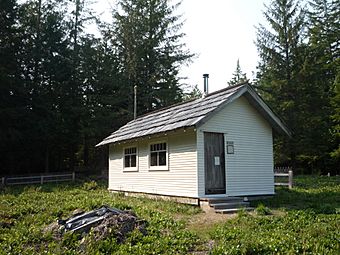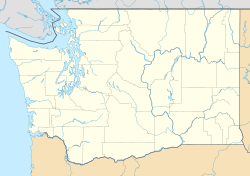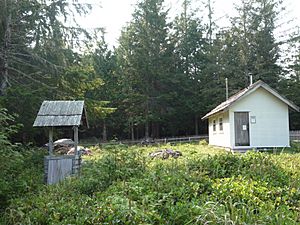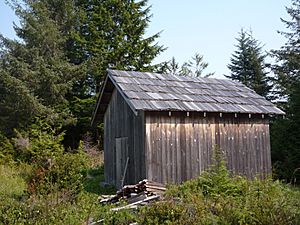Peter Roose Homestead facts for kids
Quick facts for kids |
|
|
Peter Roose Homestead
|
|

The Peter Roose house, built in the 1930s.
|
|
| Location | About 0.4 miles (0.64 km) north of Cape Alava Trail, 1.9 miles (3.1 km) west of Ozette, in Olympic National Park |
|---|---|
| Nearest city | Ozette, Washington |
| Area | 34 acres (14 ha) |
| Built | 1908 |
| Built by | Peter Roose |
| MPS | Olympic National Park MPS |
| NRHP reference No. | 07000723 |
| Added to NRHP | July 13, 2007 |
The Peter Roose Homestead is a special historic place in Washington. It was settled by Peter Roose, who came from Bollnäs, Sweden, in 1907. This homestead is located inside Olympic National Park. It was added to the National Register of Historic Places in 2007 because of its importance.
Contents
Why This Place Is Important
The Peter Roose Homestead is important for a few reasons. It shows us what the last period of homesteading was like in western Washington state. Homesteading was when people claimed and settled land.
This site also helps us understand how immigrant families from Scandinavia lived off the land. They settled in and around Ozette Lake. The buildings were made from local materials. They have lasted well even in the very wet climate. The whole area still looks much like it did back then.
Buildings and Structures at the Homestead
The historic area covers about 34 acres (14 ha). It includes five important buildings and structures:
- The Peter Roose Cabin, 48°09′40″N 124°42′25″W / 48.16115°N 124.70697°W.
- The Root House, 48°09′40″N 124°42′27″W / 48.16123°N 124.70745°W.
- The Sheep Barn, 48°09′43″N 124°42′23″W / 48.16203°N 124.70641°W.
- The well, 48°09′41″N 124°42′25″W / 48.16125°N 124.70683°W.
- The fencing which encloses the property.
History of the Homestead
The Ozette Lake area is on the Olympic Peninsula in Washington. It is a dense temperate rainforest. Large trees like Sitka spruce, western red-cedar, and western hemlock grow here. This area was originally home to the Makah people.
The Makah People and Ozette Village
Ozette Village was one of five Makah villages. It sat on a raised area above the beach at Cape Alava. This was about 3 miles (5 km) west of the lake. The village was first used around the year 0 C.E. People lived there until the 1930s.
A foot trail connected the village to the northwest end of Ozette Lake. This trail is now called the Cape Alava Trail. The Makah people used this trail to reach the lake. They also used it to get to two open bog wetlands. These are now called Ahlstrom's Prairie and Roose's Prairie.
Understanding the Prairies
These "prairies" are about 1.5 miles (2.4 km) from the beach and the lake. They are not like the grassy prairies you might imagine. Instead, they are wet, peaty bogs. They are covered mostly by mosses, sedges, and low-growing shrubs.
The Makah used both Ahlstrom's and Roose's prairies. They gathered berries, Labrador-tea, and materials for baskets there. They also hunted elk, deer, and black bear. Makah people and early settlers said that the Makah regularly burned these prairies. This kept the bogs open and stopped trees from growing. Bog cranberry (Vaccinium oxycoccus) grew only in these prairies. It was an important food and a valuable item for trading.
Peter Roose's Life on the Homestead
Peter Roose settled on one of these prairies. He claimed 160 acres (65 ha) under the Homestead Act. Another Swedish immigrant, Lars Ahlstrom, settled on the other prairie nearby.
Peter Roose was a carpenter. He built all his own structures from timber he cut on site. He built a log cabin to live in first. He also built a storage shed, a well, a barn, and an outhouse. He even built a sawmill. He powered it with a boat engine from a shipwreck.
Around the 1930s, he built the two-room house that stands there today. He used lumber from his own sawmill. He also built cedar picket fences around his property. The shed, well, barn, fencing, and the second house are still standing. The original cabin is gone.
Peter Roose had many sheep. He grew potatoes, vegetables, cherries, strawberries, and raspberries. He sold canned mutton, wool, and fruit. He also worked as a logger sometimes. He supplied lumber for the Ozette Lake schoolhouse. He traded with the Makah people. He also hunted and had a fish camp on the Ozette River. Like the Makah, he regularly burned his prairie to keep it open.
His only neighbors were a few Makah people in Ozette Village and Lars Ahlstrom. There were also a few Scandinavian families at the lake. Peter Roose lived alone on his homestead until he died around 1944. The Ozette Lake and Cape Alava areas, including Roose's homestead, became part of Olympic National Park in 1953.
Homesteading in Washington State
Peter Roose was part of a large group of Scandinavian immigrants who came to the Pacific Northwest. He arrived in the U.S. in the early 1900s. By this time, good farming land was hard to find. Immigrants often had to settle in more difficult areas, like the Olympic Peninsula.
Challenges of Settling the Land
The climate here was mild, but the forest was very dense. It was hard to clear the land. The ground was steep, and the mild ocean climate meant it was almost always damp. However, Scandinavians from their home countries and from the Midwest were drawn to the area. They liked the lack of snow. They also thought the land was fertile because such large trees grew there.
The Ozette Lake area saw its first group of homesteaders around 1890. Most of them were Scandinavian. This community was very isolated. People relied on themselves and each other. In 1897, the Washington Forest Reserve was created. This initially made the Ozette Lake area off-limits for homesteaders. Many people left the area. But the Reserve was made smaller in 1900. Ozette Lake was opened for homesteading again. A second group of Scandinavian homesteaders then settled there.
The Difficult Journey to Ozette Lake
Getting to Ozette Lake was a very hard journey. During this time, railroads went to Seattle and Portland. From there, people wanting to homestead would travel by ship to the Makah village of Neah Bay. This village is on the Strait of Juan de Fuca.
At Neah Bay, they would hire Makah canoeists. These canoeists would take them to the mouth of the Ozette River or Cape Alava. From the beach, homesteaders had to carry all their belongings inland. They walked on Indian trails or pushed through dense forest. An overland route approached the east side of Ozette Lake from Clallam Bay. This was a 25-mile-long (40 km) foot trail. It is now the Hoko-Ozette Road. No roads reached the area until the 1920s.




